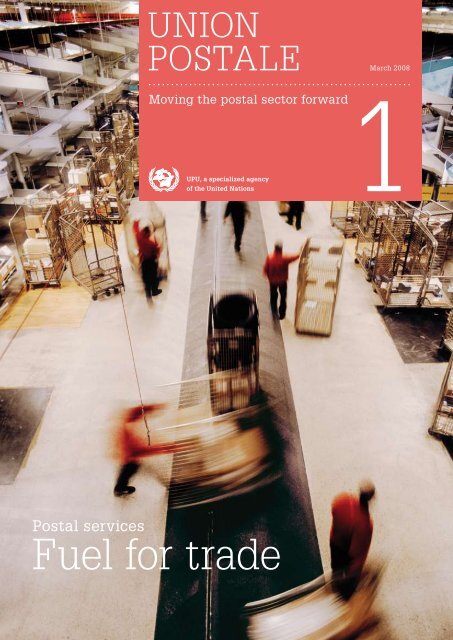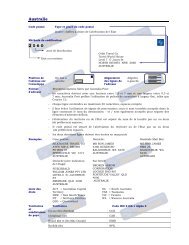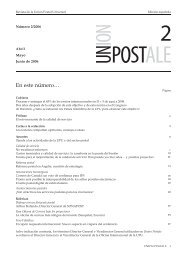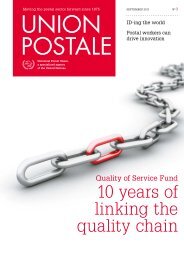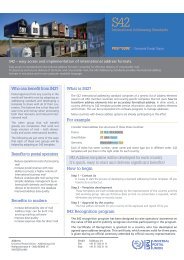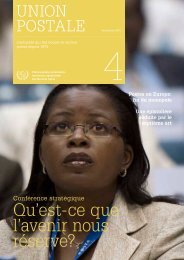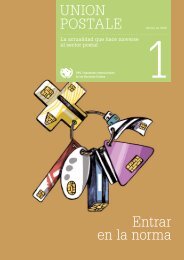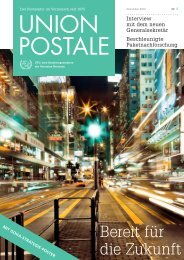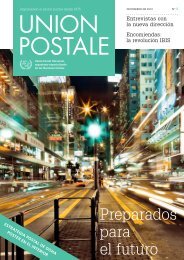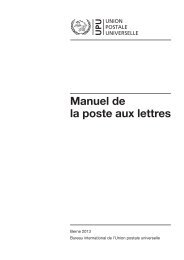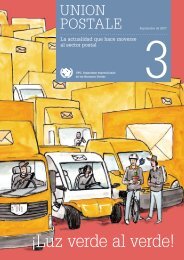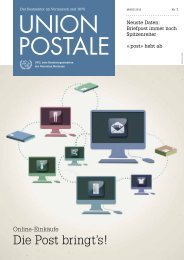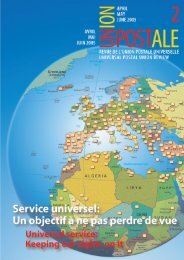English pdf 4.95 mb - UPU - Universal Postal Union
English pdf 4.95 mb - UPU - Universal Postal Union
English pdf 4.95 mb - UPU - Universal Postal Union
Create successful ePaper yourself
Turn your PDF publications into a flip-book with our unique Google optimized e-Paper software.
Editor’s noteA world without the Post? Get real!If the national – or even worldwide– postal network were somehow todisappear overnight, it would take asizeable chunk of the economy withit. Day in and day out, individuals,businesses, organizations and governmentservices rely on postal operatorsto transport millions of letters,parcels and other express items fromone end of the planet to the other.Not to mention the numerous financialservices also channelled via thepostal network.Countless businesses and otherentities could simply not survive withoutthe postal sector. And while it istrue that this public service is facingever stiffer competition from othermodes of communication, it still remainsa key driver for the economyin general, and increasingly also forthe ever greater nu<strong>mb</strong>ers of smallbusinesses and micro-enterprisesbeing spawned by new technologies.Our lead article explains all.The growth of the Internet andother new technologies has not hadthe feared impact on traditionalpostal services. In fact, Posts havebeen busy updating and improvingtheir services to ensure they continueto respond to their customers’ evolvingneeds.The letter post, which had beenwidely expected to be killed off byelectronic substitution, is a case inpoint. The best known of all postalproducts is fighting back and holdingits own in the marketplace thanks tothe promotional power and effectivenessof the written word. Even personalletter-writing could be about toenjoy a renaissance, thanks to theefforts currently being made to revivethe art of correspondence. E-mail, text messaging and mobilephones all offer a quick communication“fix”, but can they ever havethe same emotive power as a realletter? Our article on page xx recallsthe impact of the personal letter onan individual and on a society andits history.One postal customer who canvouch for the pleasure of the handwrittenmissive is Father Christmas,aka Santa Claus, whose postbagbulges with upwards of six millionletters as the festive season approaches.He, at least, still believes inthe future of the letter.Rhéal LeBlanc, editor-in-chiefISO and <strong>UPU</strong> to work hand in handCharlie McCreevy, European commissionerfor the internal market and services, on27 February 2008, the day the third postaldirective was published in the European<strong>Union</strong>’s Official JournalThe International Organization forStandardization (ISO) and the <strong>Universal</strong><strong>Postal</strong> <strong>Union</strong> agreed on 30 Januaryto find ways to improve the exchangeof information for finalizingstandards of mutual interest to thetwo organizations.In an increasingly specialized technologicalenvironment, closer cooperationin standardization workhas become essential. Furthermore,postal market developments have ledto new standards being developed tomeet the need for enhanced qualityof service. As postal operators diversifytheir activities, they need to operatein a standardized environment.“The <strong>UPU</strong> has already developedmany standards for the processing ofphysical mail,” said <strong>UPU</strong> Director GeneralEdouard Dayan. “We now needto focus on standards for electronicand financial services. The cooperationagreement with the ISO is intendedto do just that.”ISO Secretary General AlanBryden added: “The agreement willensure that postal services increasinglybenefit from globally relevantstandards, making the best use of thespecific expertise available in the <strong>UPU</strong>and the multi-sector, multi-stakeholderplatform of ISO”.A contact committee will implementthe provisions of the agreementso that the ISO and the <strong>UPU</strong> willeach be able to incorporate in itsown standards references to the standardsof the other organization. JD1/2008 <strong>Union</strong> <strong>Postal</strong>e ·
24th <strong>UPU</strong> Congress to be held in GenevaIn view of the situation that persistedin Kenya, the <strong>Universal</strong> <strong>Postal</strong> <strong>Union</strong>’sCouncil of Administration decided on8 February to change the venue ofthe 24th <strong>Universal</strong> <strong>Postal</strong> Congressfrom Nairobi (Kenya) to Geneva(Switzerland).The <strong>Universal</strong> <strong>Postal</strong> Congress,which takes place every four years,will be held at the Geneva InternationalConference Centre from 23 Julyto 12 August 2008, bringing togethersome 1,500 delegates from 191 <strong>UPU</strong>me<strong>mb</strong>er countries.A resolution adopted by theCouncil recommends, however, thatCongress approve Kenya’s chairmanshipof the 2008 Congress as well asthe chairmanship of the <strong>UPU</strong> Councilof Administration from 2009 – 2012.This resolution also recommends thatNairobi be promoted as the venue forthe <strong>UPU</strong> Strategy Conference in2010. Kenya has not yet communicatedits response to this resolution.The International Bureau willorganize the Congress with the supportof the Swiss Government andSwiss Post. For further informationabout the 24th <strong>Universal</strong> <strong>Postal</strong> Congress,go to www.upu.int. RLA view of Lake Geneva and itsfamous water fountain.Gulf region to test RFID technologyIn a project coordinated by Qatar’spostal authority, Q-Post and twoother neighbouring Posts are testingvarious RFID (radio frequency identification)technologies to measurequality of service in the Gulf region.Since the beginning of March,the operators have been measuringtransmission times for letter postbetween Qatar, the United ArabEmirates and Saudi Arabia, usingRFID chips read remotely and withoutdirect visual contact, by means ofseven RFID readers or gates installedin mail processing centres.The project aims to study theprocess for integrating and interconnectingtwo separate technologiesvia some 4,000 “semi-active” and“passive” chips concealed in testenvelopes. The three-month projectwill provide specific information onthe co<strong>mb</strong>ined use of different technologiesfor the <strong>UPU</strong>’s global qualityof service monitoring system. Eventually,this system will use RFID technologyto measure the time taken bythe destination country to forwardincoming mail to the final deliverypoint. This will enable a link to beestablished between quality of serviceand the rate of remuneration ofthe destination countries for themail.At the <strong>Postal</strong> Operations Councilin January, the quality of serviceproject group decided to go aheadwith this system and to focus on theinteroperability of different technologies.Various standards will be definedthis year, and the global monitoringsystem will enter its first pilotphase in 2009. It will then be extendedto all <strong>UPU</strong> me<strong>mb</strong>er countries.As well as being a helpful tool for calculatingterminal dues, this systemcould be used by operators to improvemail flows. LW1/2008 <strong>Union</strong> <strong>Postal</strong>e ·
The Post was one of the first sectorsto be affected by globalization.© Photo The Post SwissLocal access toglobal markets · <strong>Union</strong> <strong>Postal</strong>e 1/2008
The postal sector promotes trade, making it an importantdriver of the global economy. More specifically,postal sector players are the preferred logistics providersof micro and small businesses, in both developingand industrialized countries.ByLaurent WidmerArmed with a computer, an Internet connection, a camera,and plenty of entrepreneurial spirit, Léontine Diouf’srecent initiative is enabling small traders from variousmarkets in Dakar (Senegal) to participate in world trade,selling traditional scarves, sculptures, shoes and otheritems, via her www.shopduweb.com website. Most ofthe customers are based in Senegal, but they also comefrom abroad. “We only have a small nu<strong>mb</strong>er of customers,but I negotiate prices for them, collect the money bymoney order and then send them their purchases bypost,” explains Diouf.Her small business has opened up a vast internationalsupermarket in which these traders can sell their handicrafts.A shop window on the Web does not cost much,and it can be run from just about anywhere in the world,provided there is an Internet connection, a payment solutionand a logistics service for dispatching the goods.Thanks to technological progress and the Internet, themarket is open all hours to millions of web surfers.And far from being left behind in this rapidly changingenvironment, postal operators, often the most suitablelogistics providers for the small dispatcher, are benefitingfrom the new volumes generated by this type of commerce.“The Post has close links with Customs,” pointsout Michael Taillie, who has just signed a three-yearagreement between his New Zealand business promotioncompany and the Post. “We have chosen the Post as apartner because it is the simplest and most economicaldispatch solution for us. And as New Zealand Post is a<strong>UPU</strong> me<strong>mb</strong>er, we have access to the whole of the internationalmarket.”The physical InternetWith 660,000 post offices covering just about all cornersof the earth, the postal network is one of the world’s biggestphysical networks, and its economic importance isconsiderable. The postal services of the European <strong>Union</strong>countries have a turnover of some 88 billion EUR, or 1%of the Community’s gross domestic product (GDP). InGhana, the transport sector represents 9% of the GDP,and is of strategic importance to the country’s economy.The logistics sector, also called the “physical Internet”, isa key determinant of a country’s competitiveness. Accordingto the Performance Index published by the WorldBank at the end of 2007, “Success in integrating globalsupply chains starts with the ability of firms to movegoods across borders rapidly, reliably and cheaply. But forthe poorly connected, the costs of exclusion are considerableand growing, and the risks of missed opportunitiesloom large, especially for the poorest landlockedcountries, many of them in Africa.”“Without the Post, our business would not exist”By providing the universal service, postal operators offerlogistics solutions to businesses both small and large.They give them local access to a global network, playinga key role in the economy at the regional, national, andeven international level. “Without the Post and the qual-1/2008 <strong>Union</strong> <strong>Postal</strong>e ·
The <strong>UPU</strong> and the International Telecommunication<strong>Union</strong> have teamedup to establish telecentres in postoffices in Bhutan and Afghanistan.In fact, the vast majority of telecentres offer the possibilityto retrieve information only, a problem highlighted inthe 2007 – 2008 UNCTAD (United Nations Conference onTrade and Development) Information Economy Report.This report criticized the limited support provided by telecentresin areas such as advertising, accounting, bankingoperations, microfinance, payment processing, importand export, access to trade, data storage and management,tax matters, innovation, and research and development.Telecentres therefore need to extend their activities andoffer customized support to private individuals. For example,the creation of a comprehensive website containinginformation for visitors could have a positive impact onthe growth of tourism and the nu<strong>mb</strong>er of overnight staysin a region. A website could also be used as a shop wheremicro or small and medium-sized business could developthe sale of their products. Like the micro-credit, thiswould serve as a tool for micro-businesses in developingcountries to sell their goods throughout the world. Awebsite for displaying the goods, e-mail for placingorders, financial services and goods transport facilities:these are the services a micro-business needs in order tooperate. “Providing these services, backed up by expertadvice, would be enough to enable these businesses toparticipate in world trade. We are familiar with the microcredit,now the Post is offering international microtrade,”explains Anson.Challenges aheadBut how could this model be implemented on a widerscale? International transfers, and also the dispatch ofgoods – the final stage of Internet sales – present challengesin terms of price, time and customs clearance, allof which represent obstacles to South-North trade (seearticle on e-commerce, <strong>Union</strong> <strong>Postal</strong>e 4/2007).Paul Donohoe, e-business programme manager with theInternational Bureau, is aware of the problems. “As partof its cooperative efforts with the World Trade Organization,the United Nations Conference on Trade and Development,and the World Customs Organization to developglobal strategies and solutions to meet these challenges,the <strong>UPU</strong> and its me<strong>mb</strong>ers are working with online tradersto develop new standards allowing improved qualityof service, and create new services to facilitate dispatchand delivery of items purchased on the Internet in theindustrialized countries and in a South-North direction.Our challenge consists in constantly reviewing internationalrates structures in order to provide South-Northpostal dispatches at affordable prices.”These challenges are within the reach of postal operators.“Using funds available through the “Aid for Trade”programme, which they would have to apply for, operatorswould be able to make considerable improvementsto the quality of service, play a key role in developingworld trade, provide local access to the global logisticsnetwork, and thus develop international microtrade, anew economic model,” adds José Anson.1/2008 <strong>Union</strong> <strong>Postal</strong>e · 11
The futureof letter postWith the proliferation of new technologies, is letterpost fated to disappear or will it remain a core postalactivity?ByDora PrecupIllustration:SaschaTittmannBecause one communication medium never entirelyreplaces another, letter post remains a core activity in thecommunications market. By fine-tuning their strategiesand offering new services, postal operators are affirmingtheir confidence in the future of letter post. It is increasinglybeing redefined as a versatile service based moreand more on marketing principles and adapted to newtechnology.Despite the impact of new technology on mail volumesand the Post’s overall communications market share, letterpost continues to thrive. This activity sector, comprisingletters and small packets up to 2 kilogrammes, as wellas newspapers and books, still accounts for the majorshare of postal revenues in all regions of the world, exceptAsia and the Pacific, where financial services predominate.Between 2000 and 2006, letter mail volumes remainedsteady in industrialized countries and in Latin America.They have even seen rapid growth in the developingcountries of Eastern Europe and the Commonwealth ofIndependent States (CIS). In other regions, however,1/2008 <strong>Union</strong> <strong>Postal</strong>e · 13
traditional letter post is struggling. Over the same period,there was a decrease in volumes in African, Arab andAsian countries.These variations from one region to the next stem frommany factors. According to Ken McKeown, director ofmarkets development at the International Bureau, ahealthy and flourishing economy is a strong driver ofgrowth in mail volumes. “As the economy grows, therole of the postal sector as an intermediary becomes moreimportant; consumers, businesses, government servicesand other non-governmental organizations make greateruse of postal services to communicate and exchangegoods and services. In the CIS countries, for example, theeconomic boom has generated robust postal activity.”In Slovenia, domestic letter-post volumes have increasedby nearly 58% since 2002, with advertising mail volumegrowing by 120%. “The establishment of large companiesand banks in Slovenia’s market has led to increaseddomestic mail volumes,” points out Aleš Hauc, directorgeneral of Slovenia Post.An efficient network also reassures customers. BurkinaFaso’s designated postal operator, Sonapost, has investedmuch in improving quality over the last few years and isnow reaping the benefits. In the words of Sonapost’sbusiness director, Koutou Sommanogo, “the express mailservice represents the major share of postal revenues. Alltelephone and water service bills are also delivered byus”.In Africa, as in all developing countries, water, telephoneand electricity companies are the largest mailers and representenormous potential growth for postal operators.In the Asia-Pacific region, which generates the largestvolume of letter mail in the world after the industrializedcountries (44.4 billion items in 2006 or 10% of globalvolume), some foresee healthy growth. Zhang Kun, incharge of China Post’s international business, sees greatpotential in this sector. “A growing economy points to apromising future for letter post. With new marketingstrategies come new possibilities for letter mail.”14 · <strong>Union</strong> <strong>Postal</strong>e 1/2008
At press time, Pitney Bowes had just published a new paper entitled The Future of Mail, availableon their website at: http://www.postinsight.com/files/MAILTRENDS_final_2008_v10-1.<strong>pdf</strong>From paper to digital formatAccording to the Institute for <strong>Postal</strong> Research and Forecastingin Paris, administrative mail (bills, account statements,etc.) is the type of mail most threatened by theelectronic revolution. Nevertheless, despite the variouselectronic services used for managing transactionsbetween households, government agencies and socialorganizations (online tax returns, bill payment and Internetaccess to account statements), studies show that peoplestill put their trust in traditional mail.In a 2007 Denmark Post survey, 75% of respondents preferredreceiving information from businesses or governmentagencies by post rather than e-mail. They took communicationsfrom companies more seriously if they arrivedby post than by computer.The Pitney Bowes company obtained similar results.“Even with some 90% of consumers in the United Statesand more than 70% in Europe using both paper and electronicmedia to pay their bills, an overwhelming majoritystill prefer paper,” said analyst Alex Fu in a study conductedlast year.Another Pitney Bowes study carried out in 2007 also confirmedthe preference for traditional mail: 73% ofrespondents preferred traditional mail for receiving advertisingfor new products and offers from businesses theypatronized; 18% preferred e-mail. And when askedabout receiving unsolicited information from companiesthey did not use, a surprising 70% of respondents saidthey favoured traditional mail.“This study clearly shows that mail is still the most effectivemarketing tool for communicating with customers,”says Stacy DeWalt, vice-president of marketing and marketdevelopment with Pitney Bowes.Exploring advertising mail’s potentialToday, a sizeable share of postal traffic comes from directmail. According to <strong>UPU</strong> data, direct mail accounts for atleast 38% of domestic letter-post volume, compared with8% for international letter post. Aimed at direct marketing,letter post offers businesses the opportunity todevelop a long-term relationship with their customers.1/2008 <strong>Union</strong> <strong>Postal</strong>e · 15
Global nu<strong>mb</strong>er of letter-post items(in billions)Domestic service2000 34,12001 36,22002 26,42003 24,0200 26,8200 29,8200 33,6International service (incoming)2000 ,52001 ,02002 ,22003 ,0200 ,8200 ,6200 ,5<strong>Postal</strong> revenue (in billions of SDR)2000 157,22001 156,62002 159,92003 164,12004 175,22005 181,22006 204,8At 31 Dece<strong>mb</strong>er 2006, 1 SDR = 1.50 USDSource: <strong>UPU</strong> <strong>Postal</strong> Statistics 2006For example, the Belgian Post’s direct mail service offerslocal addresses in the destination countries and thus anopportunity to target an ever more diverse audience. Byselecting a “local presentation” for their direct mail items,businesses are certain to get the response they want fromtheir international customers. In markets with a burgeoningadvertising sector, mail offers tremendous potential.The Posts in Tunisia, Morocco and China, for example,have an infrastructure that enables them to realize thispotential (special direct mail delivery centres, databasesand consulting agencies for customers).New productsNew technologies also make it possible to develop innovativeproducts. Posts can optimize the design, productionand dispatch of documents and offer innovative services.Hybrid mail (letters or publications printed locally to theintended recipients from electronic data supplied by thecustomer) offers the latest in technological solutions.Since 2005, hybrid mail has enjoyed an annual growth16 · <strong>Union</strong> <strong>Postal</strong>e 1/2008
Whereis yourpostcard?It might just be a new way of finding penpals. The websitewww.postcrossing.com enables visitors to send realpostcards to other people who surf the website, and alsoreceive some in return. With just a few clicks of themouse, visitors gain access to correspondents’ addresses.For every card sent, you receive one back. At press time,40,000 people from 178 countries were registered on thesite, and more than 900,000 postcards had been posted.The website also enables a person to chart the distancescovered by the postcards, locate registered me<strong>mb</strong>ers andfind out what they prefer in terms of images or stamps.Why was the website developed? “Because, there arelots of people who like to receive real mail,” writes thesite’s author. “The element of surprise of receiving postcardsfrom different places in the world (many of whichyou’d probably never have heard of) can turn your mailboxinto a box of surprises – and who wouldn’t like that?”LWrate of 14% among postal operators, an indication ofhow important this service is for maintaining letter-postmarket share and offsetting the lost revenue from lowertraditional mail volumes.Today, 22% of countries offer a domestic hybrid mailservice, while 13% provide an international service. Still,international hybrid mail volumes remain small, only 1%according to Deborah Spring, who heads the internationalhybrid mail department at Australia Post. All thesame, Spring, who chairs a working group charged withdeveloping a worldwide hybrid mail service under theauspices of the <strong>UPU</strong> Telematics Cooperative’s advancedelectronic services user group, has high hopes for thismarket.“Hybrid mail could help postal operators maintain theirmarket share in letter post and even recoup what hasbeen lost to the competition. To do this, however, we willneed the <strong>UPU</strong>’s assistance to ensure the interconnectionof systems and the exchange of databases between Postsbased on international standards and regulations.”Another option operators have for maintaining revenuesfrom traditional mail is to develop an electronic equivalent,such as the electronic registered letter, which hasmade some progress in the last few years. MAILEVA, asubsidiary of France’s La Poste, acts as a platform for managingmail via the Internet. An electronic registered letteris dispatched and processed by the Post, which then deliverselectronic proof of the posting in the form of a certifyingpostmark. With the aid of technical and IT facilities,Posts can guarantee a legal and sustainable archiving systemthat makes it easier for businesses and individuals toexchange documents.Quality of service: a daunting challengeQuality of service is a key component of postal development.Letter-post services need to perform on a par withthe new services offered by the competition. The situationin Africa and Latin America, where private operatorscontrol a large share of the postal market, gives causefor concern. While designated operators in Latin America,not counting Brazil, have a 10 to 40% share of the postalmarket, the extent of that market as a whole is difficultto determine because of insufficient data.For Rudy Cuadra, regional programme manager at theInternational Bureau for Latin America and the Caribbean,general postal market estimates are important fortaking the measures needed to improve the system. Theintegrated postal reform and development plans preparedby the <strong>UPU</strong> set up the structures needed to regulatethe market and help operators to improve postalservice performance and compete on an equal footing.Faced with unfair competition, the Posts of Burkina Fasoand Côte d’Ivoire have understood that their strategiesmust serve the population’s interests. Negotiations havebegun between the Post and smaller municipalities withthe aim of guaranteeing quality service. For Koutou Sommanogo,PostEclair (a rapid mail collection, processingand delivery service) has enabled the Sonapost group tokeep customers and strengthen its customer relations. Asecond aim is to develop the post office box service. In theview of Antoine Yoffo, the Ivorian Post’s director of internationalrelations, home delivery is a priority in the overallcampaign to revive letter post activity in the country.1/2008 <strong>Union</strong> <strong>Postal</strong>e · 17
Letter-writinglives onIs the personal letter a thing of the past?Without a doubt it has been overshadowedby the Internet and the mobile phone,but examples of the special role it plays ininterpersonal communication still abound.ByDora Precup18 · <strong>Union</strong> <strong>Postal</strong>e 1/2008It is hard to say exactly how many personal letters andpostcards there are in the overall letter-post volume, butpostal operators in the major industrialized countries estimateinterpersonal correspondence at between five and11% of the volumes they handle.Nowadays, putting pen to paper, buying an envelope andchoosing a nice stamp is often seen as old-fashioned orsentimental, but there is still no substitute for the friendlyinformality of a personal letter (or a greeting card or postcard).Nothing else can provide the same genuine personaltouch.In the United States, where in 2006 the postal servicehandled a world-beating 200 billion (domestic) letter-postitems, the Greeting Card Association, which representsover 280 greeting card manufacturers and suppliers inthe United States and elsewhere, estimates that Americanconsumers buy seven billion greeting cards a year,70% of which go by post.Despite the 500 million online greeting cards sent aroundthe world each year, the association believes they arerarely a substitute for a traditional card. As the associationexplains, “Although e-mail, text messaging andphone calls are valued by Americans for helping themcommunicate with family and friends, the majority ofAmericans say that they prefer the old-fashioned handwrittencard or letter to make someone feel truly special.”Although letter writing may appear to be declining inpopularity, many private individuals, businesses andpostal operators are eagerly promoting it. A prime exampleis the <strong>Universal</strong> <strong>Postal</strong> <strong>Union</strong>’s international letter-writingcompetition for young people, now in its 38th year.Some six million young people take part in this annualcompetition, judged each year with UNESCO assistance.Schools, foundations and writing workshops also do theirbit, working with Posts to promote the art of writing. TheAustralian, Indian and Russian Posts all organize annualletter-writing competitions on a specific theme, independentlyof the <strong>UPU</strong> initiative.
Letters: defendersof human rightsMeanwhile, in France, Grignan’s annual letter-writing festival,held in honour of the renowned 17th century letterwriter, Madame de Sévigné, provides various opportunitiesfor people to write a letter to a friend, a relative or astranger. The letters are then delivered free of chargeanywhere in the world.This year, the United States <strong>Postal</strong> Service (USPS) is collaboratingwith TV channel HBO to promote the art ofletter writing, with a mini-series about John Adams, thesecond president of the United States, who wrote over1,100 letters to his wife in the course of his lifetime. InFebruary and March, the postmark on around three billionletters will consist of a famous Adams quotation:“Let us dare to read, think, speak and write”. “The <strong>Postal</strong>Service is trying a different approach in this day of instantmessaging and e-mails to emphasize how much morepowerful a handwritten message can be”, says a USPSspokeswoman of the joint venture with HBO.“Everyone has the right to freedom of opinion andexpression; this right includes freedom to hold opinionswithout interference and to seek, receive andimpart information and ideas through any media andregardless of frontiers.”As we mark the 60th anniversary of the <strong>Universal</strong>Declaration of Human Rights, the role of the postalsector in the application of article 19 of the Declarationis clear. <strong>Postal</strong> operators promote freedom ofexpression by delivering the many letters written eachyear in support of those whose rights are infringed.The annual letter marathon organized by AmnestyInternational has become an effective means ofdefending the victims of human rights violations.Launched in 2001 by Amnesty International Poland,the marathon attracts thousand of participants fromaround the world each year. In 2007, over 40 countriestook part, sending more than 200,000 letters togovernments, calling on them to release detainees orto improve their living conditions.“Last year, the letter marathon resulted in animprovement in the situation of four of the eight peopletargeted by our campaign,” said Eric Bürki ofAmnesty International Switzerland.The marathon takes place the week before InternationalHuman Rights Day, celebrated on 10 Dece<strong>mb</strong>ereach year. Public events are held in schools andshopping centres to encourage people to take part inthis worldwide simultaneous event. DPEva Lia Wyss, a doctor of philosophy from Zurich University,shares this view: “Although the handwritten letterfaces competition from new media for private communication,it still has a special value. For both sender andrecipient, it is another way of expressing feelings. The joyof writing a letter is matched only by the pleasant anticipationfelt by the recipient.”1/2008 <strong>Union</strong> <strong>Postal</strong>e · 19
A letter is…Proof of authenticityWhen the family of former Colo<strong>mb</strong>ianpresidential candidate IngridBetancourt, who has been held captivein the jungle for six years, receiveda 12-page letter from her last Nove<strong>mb</strong>er,it was proof that she was stillalive. Reading this letter was a “verypowerful thing”, according to herhusband, who recognized the styleand handwriting of the Franco-Colo<strong>mb</strong>ian hostage. People all overthe world saw this “one hundred percent personal” letter as a universalsy<strong>mb</strong>ol of strength and courage.A love tokenIn an article she wrote last year forthe Washington Post, Chloe Kaplandescribed the pleasure she felt onreceiving beautifully decorated lettersfrom her mother every week. Theaesthetic quality of these letters wasexceptional. “My mother taught meto e<strong>mb</strong>ellish life in a way no one elsecould. She turns misfortunes intobrilliant stories – not always factualbut always thrilling (…). She takesthe ordinary and makes it trulyextraordinary. Sometimes I like tothink I see these qualities in myself.When that happens, I smile and writeher a letter – which I put in a nicelydecorated envelope, of course.”A sign of commitmentSouthwest Airlines, like many otherbusinesses, uses letters to explain toits customers the reasons for shortcomingsin its service. Business communicationexperts and consultantsknow that in certain situations a letteris far more appropriate than ane-mail.A biographical documentA letter tells a story, conveys informationand reflects the writer’s times.Biographers find handwritten lettersessential material for creating anaccurate account of a person’s life.Evidence of the pastIn Messein, France, a letter was foundin a bottle of Champigneulles beer.The letter was dated Oklahoma City,15 July 1918. It consisted of fourhandwritten pages in an envelopeaddressed by “Aunt Pete” to hernephew, Morres Vickers Liepman.This personal document was truly areflection of the times, containingreferences to the economic situationin America, the hardships of wartime,mass enlistment and the danger ofcensorship. Like any other wartimerelic, this letter was a real archaeologicalfind.A mark of respectDespite the current trend for postingmessages of condolence on websites,experts in etiquette agree that lettersare preferable to e-mails and telemessageswhen it comes to expressingsolemn sentiments.A token of friendshipAnd whether it is for an anniversaryor wedding, or for offering the complimentsof the season, the 20 cardsreceived by the average Americaneach year leave no room for doubt:the greeting card is here to stay.20 · <strong>Union</strong> <strong>Postal</strong>e 1/2008
Back to thefutureAs the postal sector continues to expand,old and new players alike are investing ininnovative technologies and cutting-edgeequipment so as to better meet customerneeds. Weathering the storm? Undergoingchange? Trends and innovation…Mail production made easyWriting, addressing, printing, signing, folding, enveloping,sealing and franking: the time-consuming letter-productionprocess cannot be resolved simply by hitting thereturn key on a keyboard. To make the mail productionprocess easier, businesses offer addressing programmes,state-of-the-art printers, enveloping machines able toproduce 12,000 letters per hour, all-in-one folding andsealing systems and franking machines. Having understoodthe volume of work involved, postal businesses andoperators are offering hybrid mail services that allow customersto outsource all these mail preparation stages.The same service is also provided at the other end of thechain. Incoming mail is opened, scanned, sent to theaddressee electronically and filed.The high-speed colour scanner witha unique drop feeder, integratedinto an OPEX rapid extraction desk.In just one step, the operator canopen, extract, identify, capture,orient, sort, print an audit trail, andoutput mail contents.ByLaurent Widmer1/2008 <strong>Union</strong> <strong>Postal</strong>e · 21
The German, Austrian and NorwegianPosts are among those that useKeba parcel stations, located ataccessible points, for mail postingand collection at any time.Sorting machines are becoming evermore efficient. Over the last 10years, the nu<strong>mb</strong>er of letters sortedper hour has risen from 36,000 to60,000.Omnipresent PostOften away from home, customers who shop online –during the day, at night or on a Sunday – need a moreflexible parcel collection service. Gone are the days ofdelivery notifications left in the letter box by the mail carrier.Customers can now collect their parcels from kiosks,service stations, railway stations and, increasingly, fromelectronic lockers. Parcels are placed in a sort of left luggagelocker, which can be opened with a code, a co<strong>mb</strong>inationof figures and letters left in the letter box or sentby e-mail or SMS. Customer benefits include round-theclockposting and collection, security and confidentiality,and the possibility of having parcels delivered at a specificstation, even when travelling on business or on holiday.For the operator, there are just as many benefits: roundthe-clockdelivery; fewer unsuccessful delivery attempts;automation of the entire logistics chain; lower logisticsand delivery costs; provision of cash-on-delivery and registereditem services; payment by card; and lower CO 2emissions. These kiosks also provide other postal services,including dispatch of parcels, letters and registered items,purchase of stamps, provision of information on postaltariffs and postcodes, access to financial services, andtracking of items.Mail sorting: ever better, ever fasterAt the beginning of the 1990s, sorting machines processedup to 36,000 letters per hour. Ten years later, thatnu<strong>mb</strong>er has almost doubled, thanks to advances in address-readingtechnology and the significant progressmade in the field of handwriting recognition technology.According to Lockheed Martin, over the last 10 years, thepercentage of handwritten addresses read by opticalcharacter readers has increased from 2% to 88%, whilethat of machine-printed addresses has increased from35% to 93%. Addresses that cannot be read automaticallyare entered by video-coding staff. Video-coding systemscan also be used remotely. Voice-coding technologyis also used (e.g. in sorting outbound international parcels),which avoids having to type the name of the countryon a keyboard, as the system will recognize it if it isread aloud.Whereas their predecessors merely read the postcode,the new sorting machines read the whole address andcheck it against an integrated database. Thanks to thesedevelopments, mail can now be sorted sequentially, accordingto the mail carrier’s round, or automatically redirectedin case of a change of address. Moreover, theseinnovations allow the nu<strong>mb</strong>er of items to be sorted ordelivered to be calculated in advance, enabling sortingand delivery centre resources to be rationalized.22 · <strong>Union</strong> <strong>Postal</strong>e 1/2008
Mail delivery by bike is already quitecommon, but, in this green age,the delivery method could becomeeven more popular among operators.Equipped with a GPS function, thenew Motorola scanner allows parcelsand staff to be located and mailto be collected and delivered at theright place and the right time.The last mile: efficiency and user-friendlinessDelivery to the addressee, representing more than 50%of the postage cost, is a key stage for postal operators.While delivery via electronic lockers (see above) or postalagencies is on the rise, most items are still delivered viatraditional letter boxes or at the doorstep. Geo-trackingsoftware makes it possible to modify the mail carrier’sround and to select the most appropriate means of transport.Surprisingly, the bicycle has not become obsolete,and some have even predicted a bright future for it. Equippedwith a battery, a bicycle can do the job of an electricscooter, which certain countries have introduced for theirpostal rounds.Between tradition and modernityTrolleys, satchels and gloves continue to be part and parcelof the mail carrier’s array of working tools. However,the scanner has now become an essential tool for a qualitydelivery service, as it serves not only as a barcodereader, but also as a telephone and GPS (allowing a carrier’swhereabouts to be detected and the carriers to keepto their delivery round), and even as a camera (for damagedparcels, etc.). Some models also read RFID chips,intelligent labels affixed to postal items and, in certaincountries, placed inside letter boxes.
24 · <strong>Union</strong> <strong>Postal</strong>e 1/2008
The interviewFair duesThe question is often asked: how are countriespaid for processing, transporting anddelivering inbound international mail andvice versa?ByRhéal LeBlancPhotos:DanielWietlisbachTo calculate the financial compensation due to countries,the <strong>UPU</strong> uses the terminal dues system. First establishedin 1969, this system continues to evolve from one <strong>Universal</strong><strong>Postal</strong> Congress to another. At the 2004 BucharestCongress, me<strong>mb</strong>er countries adopted a system aimed atcovering their actual mail processing costs. Moreover, alink was established between the remuneration receivedand the quality of service provided.As not all countries are at the same stage of developmentand there are significant variations in their mail volumes,postal tariffs and cost absorption, the aim, by the end of2013, is to progressively incorporate the developing andleast developed countries into a target system that alreadyapplies to industrialized countries.Paul Epiney of Switzerland chairs the terminal dues projectgroup, tasked with further developing the system adoptedin Bucharest and submitting a proposal to the 2008 Congress.He explains the main changes characterizing thisproposal and the challenges faced in preparing it.Please briefly describe how the terminaldues system impacts uponcountries. Why is this one of themost important issues dealt with bythe <strong>UPU</strong>?In my opinion, this is one of theorganization’s most importantprojects, as it affects countries’budgets. Terminal dues is the remunerationpaid for the processingand delivery of international letterpost, which accounts for around70% of postage costs. For postaloperators, terminal dues representan essential source of revenue thatenables them to provide postalservices in their countries.How has your group managed towork on such an important issue,taking account of the interests of allparties?In basing our work on resolutionC46 / 2004, which is aimed at thecoverage of actual costs, we havethrown down the gauntlet. Whendealing with 191 countries, compromisesoften need to be reached.We have endeavoured to hear allpoints of view, holding numerousmeetings during <strong>Postal</strong> OperationsCouncil (POC) and Council ofAdministration (CA) sessions, aswell as two workshops in Berne andsteering committee meetings.Regional round tables, culminatingin a world round table, haveallowed us to fine-tune the proposal.On this basis, we have developeda proposal aligned as closelyas possible to the resolution. Whilewe have moved in the right direction,much remains to be done. Thiswork will continue after the 24th<strong>UPU</strong> Congress.What were the biggest challengesin preparing the Congress proposal?There were many. First, agreementhad to be reached on the mostimportant principles. We establishedeight of these, one of whichwas to put into place a systemwhereby revenues would be maintainedfor the same level of mailexchanges. This was of particularconcern to developing countries. Ittook more than two years to establishthese principles. On this basis,with the International Bureau’sassistance, we conducted in-depthstudies in areas such as markets,special services, tariffs and costs.1/2008 <strong>Union</strong> <strong>Postal</strong>e · 25
However, the study on each country’sactual mail processing costswas not altogether conclusive. Ascertain operators are listed on stockmarkets, shareholders are unwillingto divulge business costs. Otheroperators do not know their actualcosts, as they do not have a reliablecost-accounting system. This madeit more difficult for us to establish aframework within which to proceed.We therefore decided to baseourselves on the domestic tariffs forindustrialized countries and tomaintain the current system fordeveloping countries, which consistsof paying terminal duesaccording to a fixed rate that canbe adjusted over time. This was theonly way of breaking the deadlock.We will try to conduct a new studyon costs during the next cycle.Another major challenge wasthe new classification of countries,a task assigned to the CA projectgroup dealing with terminal duesgovernance issues. France and theInternational Bureau did an excellentjob in this regard. The majoradvantage of the solution found isthat the so-called most advancedCould further improvements bemade to the proposed new system?Nothing is perfect. We do not meetwith all the requirements of resolutionC 46, i.e. that all countries bepart of the target system by thebeginning of 2014. It was simply amatter of being realistic and practidevelopingcountries, such as Singaporeand the United Arab Emirates,will migrate directly to the targetsystem.The Quality of Service Fund(QSF), made available to developingcountries to finance their quality ofservice projects, gave rise to no realproblems. Industrialized countriesshowed a clear will to providedeveloping countries with resourcesby maintaining the Fund andincreasing their contributions to itthrough terminal dues payments.What are the proposal’s main benefits?Does it comply with BucharestCongress resolution C 46?Pending formal approval by Congress,a consensus has beenreached and all the countriesapproved the proposal at the 2008POC and CA sessions. The mainbone of contention was the financialimpact. We have managed tolimit any potentially negative financialimpact and to protect mostcountries’ revenues. However, eachcountry is sovereign and is free tointervene or propose changes atCongress.Developing countries fear theywould lose revenue under the proposednew system. Have they beensufficiently reassured?We sought to thoroughly explainthe proposed new system at theregional round tables. We also gavecountries the opportunity to testthe system with a costing tool. Furthermore,the restricted unionsstudied all aspects of the proposal,and the International Bureau gaveseveral presentations on the financialimpact in the regions. I thinkme<strong>mb</strong>er countries feel reassuredinsofar that they approved the finalproposal. The working group, theInternational Bureau and the steeringcommittee did some excellentin-depth work on terminal dues,and it is thanks to them that wehave seen this through.26 · <strong>Union</strong> <strong>Postal</strong>e 1/2008
“Cost accounting has already beenintroduced in many countries, but thiswork must continue. A reliable costaccounting system is a prerequisite fora cost-based system.”cal. We were guided by commonsense and we understood we neededmore time to complete ourwork.For example, we would haveliked to include domestic transmissioncosts in the proposal (costspaid by the dispatching country forthe internal conveyance of inboundmail arriving at the destinationcountry’s main office of exchange),but we were unable to do so. Wewill address this aspect during thenext cycle. We had to make concessionsin the interest of me<strong>mb</strong>ercountries. In 2004, a ten-year timeframewas established for incorporatingall countries into the targetsystem by 1 January 2014. We realized,however, that things wereprogressing slower than anticipated.So for certain developing andleast developed countries, thedeadline has been pushed back.Cost accounting is an importantaspect of the work to be done visà-visterminal dues. It has alreadybeen introduced in many countries,but this work must continue. A reliablecost accounting system is aprerequisite for a cost-based system.The ship has set sail, but itneeds to call in at several ports. Wewill reach the final docking point,not tomorrow, but the day after.How will the proposal facilitate theaccession of new countries to thetarget system?The transition will be a gradualprocess. Once in the target system,new countries will not be immediatelysubject to the rules that currentlyapply to industrialized countries.They will have to meetthresholds, but a period of gracewill be granted for areas such asquality of service. A step-by-stepapproach will be taken.Does the terminal dues system gofar enough? Is it an accurate reflectionof the current market?We have often been accused ofbeing bean counters (smiles). Terminaldues should be considered in amarketing context. The letter-postsegment should be considered as amarket, not only in terms of itsfinancial side. In my view, valueaddedletter-post services, such astrack and trace, insured or regis-tered items, should be included indiscussions on terminal dues. Personally,I would like to see terminaldues considered in a broader context,a wish that has also beenexpressed by the terminal duesproject group and by countries suchas China and Australia.So terminal dues could contributeto the development of postal markets?Of course, both to the developmentof markets and in responding tocustomer needs. Certain customerswould accept longer delivery timesin return for lower tariffs. We havecarried out an important study inthis connection, but have not hadtime to analyze the results in depth.This is a complex area that needs tobe further explored during the nextcycle.How do you see the proposedmeasures for evaluating quality ofservice and establishing a link withterminal dues?We are already on the road. Twenty-ninecountries already participatein the quality of service-linked ter-1/2008 <strong>Union</strong> <strong>Postal</strong>e · 27
minal dues programme, includingdeveloping countries such as Brazil,Ukraine, Malta, Latvia and Jamaica.Thanks to the QSF, other countriesare planning to join the system byimplementing quality control systems.This is the <strong>UPU</strong>’s future. TheInternational Bureau can play amajor role in this regard. The globalmonitoring system for quality ofservice, on which the <strong>UPU</strong> is working,will prove invaluable. Owing tothe fact that countries are to beclassified in five groups, the systemwill be flexible enough to allowlow-volume countries to participate.Some countries are concernedabout the quality objectives establishedfor terminal dues. Howwould you allay their concerns?The countries have national standardsand objectives set by the regulator,so it is sometimes difficult forthem to accept the quality of serviceobjectives established to makethis link with the terminal dues theyreceive. Their internal objectives areincompatible with those associatedwith the terminal dues system. Theyare not necessarily opposed to theidea of setting a high standard, butthey have certain reservations. It’s aquestion of finding the right balance.Are you confident that the proposalsubmitted to Congress will beapproved?Certain countries could submit otherproposals, without completelychanging the proposed system. Ingeneral, once the POC and the CAhave approved a proposal, it shouldbe adopted at Congress.The letterbox“› Write to us!We welcome letters to the editor. Post a letterby mail, or send it by e-mail to rheal.leblanc@upu.int, with your name, address, telephonenu<strong>mb</strong>er and e-mail. When necessary, letterschosen for publication may be condensed.28 · <strong>Union</strong> <strong>Postal</strong>e 1/2008Breaking barriersAt Correos, distance learning (“Distancelearning offers more”, <strong>Union</strong><strong>Postal</strong>e 4 / 2007) has become a wellestablishedtraining method, highlysought after by staff and the variousbusiness segments. This trainingmethodology has enabled Correos toovercome geographical barriers andto foster the professional developmentof its more than 67,000 employees.Training, and in particular distancelearning, has become a keypart of our strategy. Given the adoptionof new technologies and thespeed with which internal changesneed to be implemented, distancelearning has become essential, reachingmore people in less time.In 2002, there were barely 1,150distance-learning participants, andthe training was largely limited tosoftware applications. The staffresponse was positive and thenu<strong>mb</strong>er of distance learners steadilyincreased, reaching 19,000 in 2005and over 50,000 in 2007 (i.e. 51%of the overall training provided).As distance learning has takenroot, the scope of the courses hasincreased to include software tools,business applications and processes,products, languages, skills and theprevention of work-related risks.The cooperation agreementssigned with various entities have enabledus to provide staff in rural anddeprived urban areas with computersand Internet access.Concepción Lagüela CarballosaHead of Recruitment and TrainingCorreos de España“
Market focusA monopoly no moreOn 1 January 2008, Deutsche Postlost its last monopoly, the exclusiveright to deliver letters under 50grammes. The other EU me<strong>mb</strong>erstates have postponed this deadlineuntil 2011, even 2013. For lettersover 50 grammes, the postal sectorhas been undergoing gradual liberalizationsince 1997. Not wanting tosee the German market slowly erodedby competitors paying rock-bottomwages, the country’s politicalIn February, Namibia’s postal service,NamPost, inaugurated its newhybrid mail centre, equipped withthe latest technology for managingbusiness mail. The new hybrid mailsystem, created in 2004 as a pilotproject, is now used by a dozen orso major customers. With its fullyautomated system, the new centrehandles all mail processing stages,enabling customers to manage theirmail in less time. Businesses simplyleft has prevailed in its fight to introducea minimum wage for the sector.After the adoption of this measure,the Netherlands announced adelay in the full liberalization of itsown market. At press time, theNetherlands was considering deferringliberalization of the postal sectoruntil July 2008.Source: le Figaro, ReutersNamibia: newhybrid mail centreprovide the centre with all the electronicdata and information needed.NamPost then prints the letters orstatements, inserts them in envelopes,affixes the postage and sortsthe mail according to intended recipients.This technological investmentis a major step towards creatingdigital automated postalservices and will open up opportunitiesfor foreign investment in thepostal sector and the country’s economy.United forhumanitarianreliefAt the World Economic Forum in Davos,three logistics and transport companies,Agility, TNT and UPS, and the UnitedNations launched two initiatives to facilitateprivate-sector support in humanitarianrelief operations. The first initiativedefines a set of 10 guiding principles designedto promote cooperation between theprivate sector and humanitarian bodies.The second one, a unique example of collaborationbetween private companies andthe humanitarian relief sector, involves theintervention of logistics emergency teams,providing logistics specialists responsiblefor airport coordination, warehousing,trucks, forklifts and transport services.These teams are ready to intervene duringthe first three to six weeks following naturaldisasters such as earthquakes, floodsand storms. The benefits of this partnershipwere first demonstrated in August2007 when Agility, TNT and UPS set upthese emergency teams in Indonesiaduring an operational exercise with theWorld Food Programme.Source: UPS press releaseSource: All Africa1/2008 <strong>Union</strong> <strong>Postal</strong>e · 29
Market focusPost and telephoneservices: Italians atthe forefrontWith its PosteMobile service, PosteItaliane becomes the first postal servicein the world to join the telephoneservices sector. PosteMobileoffers a package of unique servicesaccessible from a mobile phone.Thanks to these services, the mobilephone becomes an easy-to-use,totally secure «electronic wallet»To measure the impact of remittanceson African economies, The AfricanDevelopment Bank Group hasconducted a study which providesan overall assessment of financialflows from migrant workers worldwide,identifies mechanisms governingthe remittances market andquantifies how the flows and formaland informal channels that exist aredistributed and used. The study,which focuses on Morocco, Senegal,that customers can use with threetoll-free rate options to transfermoney to and from a BancoPostaaccount, pay bills, check a bankaccount or Postepay transactions,send telegrams and access othervalue-added services without goingto the postal counter.Source: Poste ItalianeAfrica: spotlighton migrantremittancesMali and the Comoros, describesthe strategies of the differentplayers involved, the migrants, theirfamilies and the other financial entities.These countries all have verydifferent socio-economic characteristics,but share strong migratoryand historical links with the sameindustrialized country, France. Formore details, go to www.afdb.org/diasporaSource: African Development BankTheubiquitousPostThe Korean Post plans to invest180 million US dollars this year toupgrade its operations and ITinfrastructure as part of its aim tocreate a “ubiquitous” postal network.The money will be spent onhardware and software purchases,research and development projects,creation of an advanced systemarchitecture and maintenance ofexisting systems. Dubbed “U-Post”,the postal service will make use of600 RFID readers and 40,000 RFIDtags, enabling customers to trackthe whereabouts of their mail andparcels.Source: The Korea HeraldPost offices inDutch shopsIn March 2008, the Dutch postal service,TNT Post, decided to restructure its servicesby “out-sourcing” all of its post offices.The 250 offices operated by TNT Postwill be closed and replaced with 750 newagencies located in shops throughout thecountry. This is not a first for TNT, as 1,850access points already exist at retail locations.Source: TNT, La tribune.fr30 · <strong>Union</strong> <strong>Postal</strong>e 1/2008
Get readyto win.S O LY S T I C , A 6 0 Y E A R P A R T N E R O F T H E P O S T A L S E R V I C E SGain in technological performance thanks to machines with highthroughput, specifically adapted to your needs.Invest in the future with a partner that devotes 10% of its turnoverto Research and Development (30 patents per year on average).Increase your competitive edge with solutions that offer excellentvalue for money and optimised cost of ownership: installation,maintenance, team training, ergonomics, etc.Depend on the reliability of a constructor who has been in thepostal business for 60 years.Respect the planet by choosing materials that comply with therules of an Environment Management System (ISO 14001 certified).www.solystic.comFuture postal solutions
The postal networkFacilitating affordablemoney transfersworldwide<strong>Postal</strong> Technology Centre - <strong>Universal</strong> <strong>Postal</strong> <strong>Union</strong>www.ptc.upu.int


